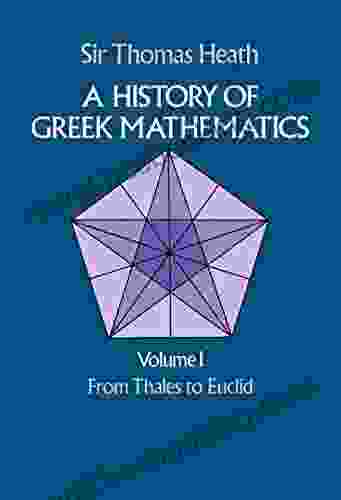From Thales To Euclid: A 3000-Year Journey Through the History of Geometry

Geometry is one of the oldest and most fundamental branches of mathematics. It is the study of shapes, sizes, and relationships in space. Geometry has been used for centuries to design buildings, bridges, and other structures. It has also been used to solve problems in astronomy, navigation, and engineering.
4.7 out of 5
| Language | : | English |
| File size | : | 7106 KB |
| Text-to-Speech | : | Enabled |
| Screen Reader | : | Supported |
| Enhanced typesetting | : | Enabled |
| Print length | : | 604 pages |
| Lending | : | Enabled |
The history of geometry is a long and fascinating one. It begins with the ancient Greeks, who made significant contributions to the field. Thales of Miletus is credited with being one of the first geometers. He lived in the 6th century BC and is said to have discovered the Pythagorean theorem. Euclid is another important figure in the history of geometry. He lived in the 3rd century BC and wrote the Elements, which is one of the most influential books in the history of mathematics.
In the centuries that followed Euclid, geometers continued to make important discoveries. Archimedes, who lived in the 3rd century BC, is known for his work on the measurement of circles and spheres. Pythagoras, who lived in the 6th century BC, is best known for his Pythagorean theorem. Descartes, who lived in the 17th century, developed analytic geometry. Newton, who lived in the 18th century, developed calculus. Einstein, who lived in the 20th century, developed the theory of relativity.
The history of geometry is a story of continuous progress. Geometers have made significant contributions to our understanding of the world around us. Their work has helped us to build better structures, solve complex problems, and explore the universe.
The Ancient Greeks
The ancient Greeks were the first to make significant contributions to the field of geometry. Thales of Miletus is credited with being one of the first geometers. He lived in the 6th century BC and is said to have discovered the Pythagorean theorem. Pythagoras, who lived in the 6th century BC, is best known for his Pythagorean theorem. He also made important contributions to the field of number theory.
Euclid is another important figure in the history of geometry. He lived in the 3rd century BC and wrote the Elements, which is one of the most influential books in the history of mathematics. The Elements is a systematic treatment of geometry that includes proofs of many important theorems. It has been used as a textbook for geometry for centuries.
The ancient Greeks made many important contributions to the field of geometry. Their work laid the foundation for the development of geometry in the centuries that followed.
The Middle Ages
The Middle Ages was a period of relative stagnation in the development of geometry. However, there were some important developments during this period. In the 9th century, the Arab mathematician Al-Khwarizmi developed algebra. Algebra is a branch of mathematics that uses symbols to represent unknown quantities. This made it possible to solve more complex geometry problems.
In the 12th century, the Italian mathematician Leonardo Fibonacci developed the Fibonacci sequence. The Fibonacci sequence is a series of numbers in which each number is the sum of the two preceding numbers. The Fibonacci sequence has many applications in geometry.
The Middle Ages was a period of important developments in the field of algebra. These developments laid the foundation for the development of calculus in the centuries that followed.
The Renaissance
The Renaissance was a period of renewed interest in the classics. This led to a revival of interest in geometry. In the 15th century, the Italian mathematician Luca Pacioli published a book on geometry that included a translation of Euclid's Elements. This book helped to spread the knowledge of geometry to a wider audience.
In the 16th century, the German mathematician Johannes Kepler developed the laws of planetary motion. Kepler's laws are based on the geometry of ellipses. This was a major breakthrough in the field of astronomy.
The Renaissance was a period of important developments in the field of geometry. These developments laid the foundation for the development of calculus in the centuries that followed.
The 17th Century
The 17th century was a period of great progress in the field of geometry. In the early 17th century, the French mathematician René Descartes developed analytic geometry. Analytic geometry is a branch of mathematics that uses algebra to represent geometric figures. This made it possible to solve more complex geometry problems.
In the later 17th century, the English mathematician Isaac Newton developed calculus. Calculus is a branch of mathematics that deals with the rate of change. This made it possible to solve even more complex geometry problems.
The 17th century was a period of great progress in the field of geometry. These developments laid the foundation for the development of geometry in the centuries that followed.
The 18th Century
The 18th century was a period of continued progress in the field of geometry. In the 18th century, the Swiss mathematician Leonhard Euler developed the calculus of variations. The calculus of variations is a branch of mathematics that deals with the optimization of functions. This made it possible to solve even more complex geometry problems.
In the later 18th century, the French mathematician Gaspard Monge developed descriptive geometry. Descriptive geometry is a branch of mathematics that deals with the representation of three-dimensional objects on a two-dimensional surface. This made it possible to solve even more complex geometry problems.
The 18th century was a period of continued progress in the field of geometry. These developments laid the foundation for the development of geometry in the centuries that followed.
The 19th Century
The 19th century was a period of great progress in the field of geometry. In the 19th century, the German mathematician Bernhard Riemann developed non-Euclidean geometry. Non-Euclidean geometry is a branch of
4.7 out of 5
| Language | : | English |
| File size | : | 7106 KB |
| Text-to-Speech | : | Enabled |
| Screen Reader | : | Supported |
| Enhanced typesetting | : | Enabled |
| Print length | : | 604 pages |
| Lending | : | Enabled |
Do you want to contribute by writing guest posts on this blog?
Please contact us and send us a resume of previous articles that you have written.
 Book
Book Novel
Novel Page
Page Chapter
Chapter Text
Text Story
Story Genre
Genre Reader
Reader Library
Library Paperback
Paperback E-book
E-book Magazine
Magazine Newspaper
Newspaper Paragraph
Paragraph Sentence
Sentence Bookmark
Bookmark Shelf
Shelf Glossary
Glossary Bibliography
Bibliography Foreword
Foreword Preface
Preface Synopsis
Synopsis Annotation
Annotation Footnote
Footnote Manuscript
Manuscript Scroll
Scroll Codex
Codex Tome
Tome Bestseller
Bestseller Classics
Classics Library card
Library card Narrative
Narrative Biography
Biography Autobiography
Autobiography Memoir
Memoir Reference
Reference Encyclopedia
Encyclopedia Randy Russell
Randy Russell Valerie Mckeehan
Valerie Mckeehan Ruth E Iskin
Ruth E Iskin Richard A Muller
Richard A Muller Willow Cross
Willow Cross Rick Revelle
Rick Revelle Ralph Stokes
Ralph Stokes Stacy Lynn Carroll
Stacy Lynn Carroll Robin Gaby Fisher
Robin Gaby Fisher Rob Craig
Rob Craig Sara Burrier
Sara Burrier Shel Perkins
Shel Perkins Kindle Edition
Kindle Edition Scott Schell
Scott Schell Todd Phillips
Todd Phillips Sally Doran
Sally Doran Robin Hemley
Robin Hemley Sara Paretsky
Sara Paretsky Richard Berman
Richard Berman Vb Leghorn
Vb Leghorn
Light bulbAdvertise smarter! Our strategic ad space ensures maximum exposure. Reserve your spot today!

 Gordon CoxMaster the Art of Boat Maintenance with "Quick and Easy Boat Maintenance, 2nd...
Gordon CoxMaster the Art of Boat Maintenance with "Quick and Easy Boat Maintenance, 2nd... Nick TurnerFollow ·5.5k
Nick TurnerFollow ·5.5k Yukio MishimaFollow ·13.6k
Yukio MishimaFollow ·13.6k Eliot FosterFollow ·18.8k
Eliot FosterFollow ·18.8k Brayden ReedFollow ·14k
Brayden ReedFollow ·14k Carson BlairFollow ·10.4k
Carson BlairFollow ·10.4k Gabriel MistralFollow ·11.6k
Gabriel MistralFollow ·11.6k Robert BrowningFollow ·6.6k
Robert BrowningFollow ·6.6k Oscar BellFollow ·5.5k
Oscar BellFollow ·5.5k

 Steven Hayes
Steven HayesEmbark on Unforgettable Adventures: Discover the Best of...
Unveiling the Enchanting Trails of the...

 Jarrett Blair
Jarrett BlairMaster the Road: Ace Your North Carolina Driver's Test...
Unlock the Secrets to...

 Brent Foster
Brent FosterDk Essential Managers Understanding Accounts: Your...
In today's...

 Isaac Mitchell
Isaac MitchellPrognosis: A Memoir of My Brain - A Journey of Hope and...
In 2013, Eve Ensler was diagnosed with a...
4.7 out of 5
| Language | : | English |
| File size | : | 7106 KB |
| Text-to-Speech | : | Enabled |
| Screen Reader | : | Supported |
| Enhanced typesetting | : | Enabled |
| Print length | : | 604 pages |
| Lending | : | Enabled |














